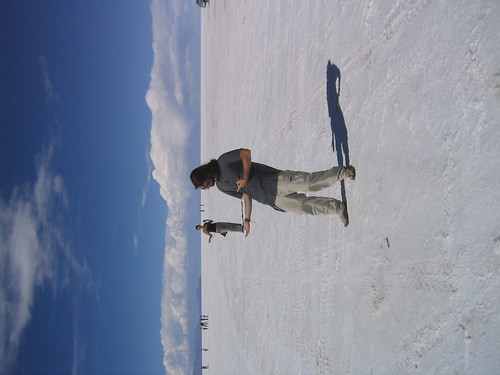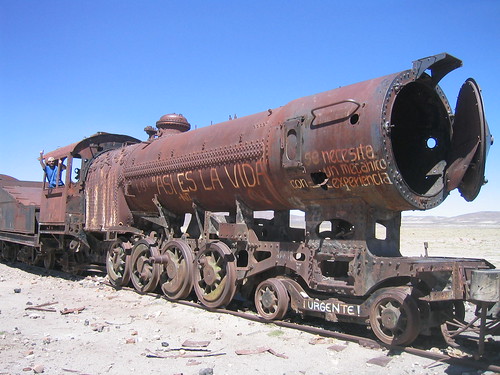 The answer is surprisingly easy. Under the rule of the Conquistadors an Indian farmer brought his "owner" a shiny rock that he had found. That rock turned out to be silver and when they looked a little more they discovered that Mt Potosi was made of the precious metal (not one penny of, incidentally, did it's discoverer ever get). It was the biggest find of silver in history and the Spanish were quick to take advantage. They used Indian slaves and some imported from Africa to pull wealth out of the earth and ship it back to Spain. Almost immediately, and for about a hundred years, the city they founded became one of the largest, and wealthiest, in the whole world. For many money came ridiculously easy.
The answer is surprisingly easy. Under the rule of the Conquistadors an Indian farmer brought his "owner" a shiny rock that he had found. That rock turned out to be silver and when they looked a little more they discovered that Mt Potosi was made of the precious metal (not one penny of, incidentally, did it's discoverer ever get). It was the biggest find of silver in history and the Spanish were quick to take advantage. They used Indian slaves and some imported from Africa to pull wealth out of the earth and ship it back to Spain. Almost immediately, and for about a hundred years, the city they founded became one of the largest, and wealthiest, in the whole world. For many money came ridiculously easy. But those who did the digging didn't have time to celebrate, between long hours of work and dying young. The conditions were, and are, terrible. Between black lung and mining accidents more than 8 Million have died since it's discovery (The Holocaust in WWII, for comparison, killed 6 Million people). The conditions then were hard, but they aren't too much better today. Today the mines are collectively owned by the miners and their pension goes to their relatives if they die young. Which is important, because even today statistically Potosi miners will probably die within ten years of stepping foot underground the for first time.
The next stop was Salar de Uyuni (The salt flats of Uyuni) one of the most psychedelic landscapes I've ever seen. The salt flats is a "lake" that extends for about 12,000 square kilometers only there is more salt than there is water. In the dry season you can stand ankle deep in pure white salt.

Io, our pocket-sized German.
The salt sea was only the first day, and we spent another three traversing this exotic land.
Sadly, one morning we lost both Io and Nick. They both had flights to catch from Santiago, Chile and this tour took them close to the border so they hopped off at a tiny town in the middle of nowhere.
Unfortunately our time in Bolvia also quickly drew to a close. From Uyuni we took an all night train to Tupiza on the worst train ever invented (I believe it was designed by ergonomic engineers with the goal of making it an utterly miserable experience for those too cheap to pay for first class). We passed, on a sleepless cramped night,
From there it was a hop skip and a jump to the border where Tyler and I both took a deep breath and got ready for another horrendous border battle. We bought tickets, careful to pay little attention when they tried to confuse us by talking about time in Argentina and Bolivia. We didn´t want to be distracted by details and focused on getting the right price before we walked across the border. We had a few hours before the bus so we did some internet, spent the last of our Bolivars, and strolled to the border. They rushed us through the process, with several people in the long line telling us to cut ahead of them and 20 other patiently waiting latinos. It was uncomfortable to cut ahead, as the preferential treatment likely came due to our light skin, but it is also uncomfortable to tell people you don´t want the favor they are offering.
Having rushed through the border we casually walked up to the bus and arrived half an hour early. We checked in to see where the bus would arrive and the woman only shook her head and pointed at the clock above her. Argentinian time is an hour ahead. Despite the fact that everyone we encountered at this border town giving us every possible break we still missed our bus. Doh!

Onward to Argentina!
Very nice post! In the north of Argentina you can also extreme high altitudes like in bolivia. The key to move in those places in to move slowly.- In salta for example you can find one of the highest wineyards of the world, at more than 2,800 meters about sea level (region of Yacochuya). People work in altitudes that a nomal person can just barely breathe...
ReplyDeleteOk, so I found this post 4 years after you wrote it, but I'm glad you found a use for my photo. Happy travels!
ReplyDelete